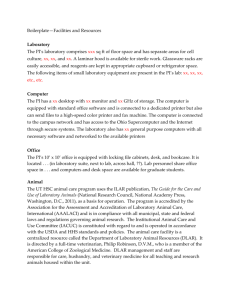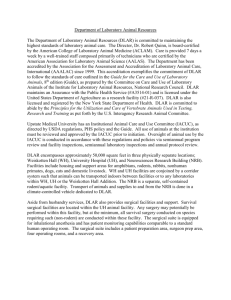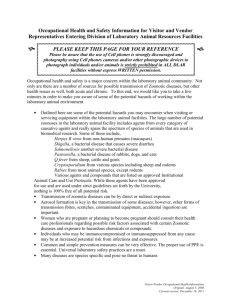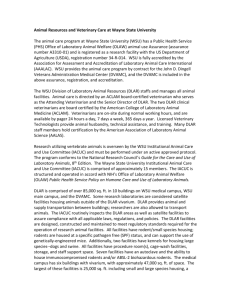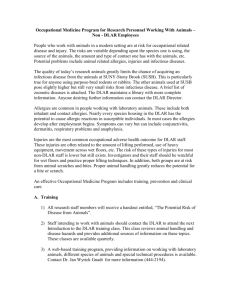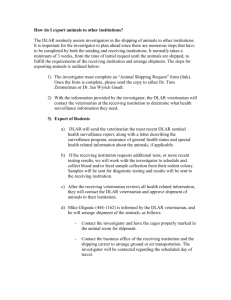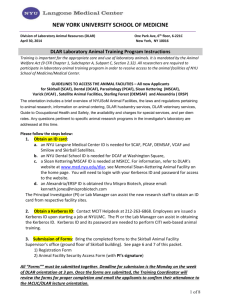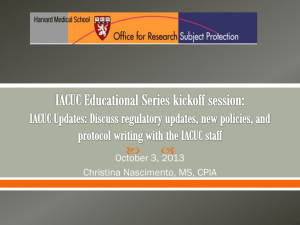Use of Animals in Research
advertisement
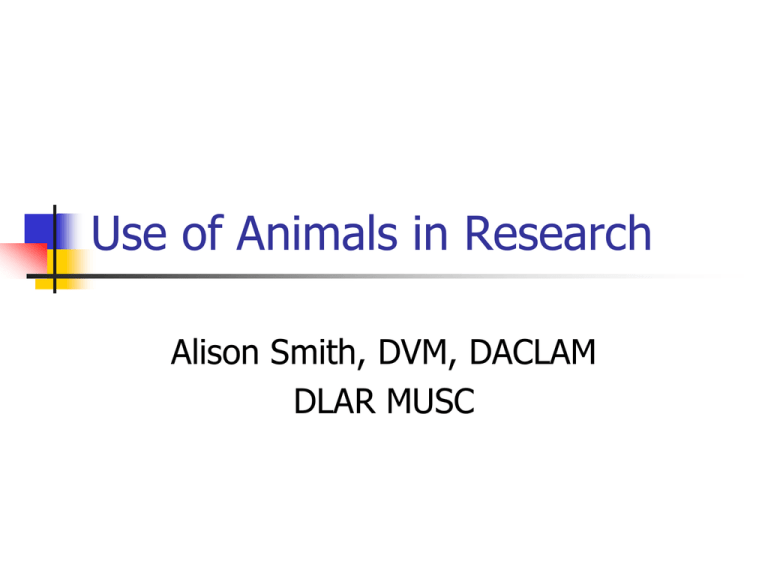
Use of Animals in Research Alison Smith, DVM, DACLAM DLAR MUSC DIVISION OF LABORATORY ANIMAL RESOURCES (DLAR) Consultation Animal Care Surgery and Postoperative Care Animal Ordering Collaborative Research Technical Services US Laws and Regulations Animal Welfare Act Health Research Extension Act – PHS Guidelines NRC “Guide for the Care and Use of Laboratory Animals” Other Guidelines Veterans Administration State and local “Guide for the Care and Use of Agricultural Animals in Agricultural Research and Teaching” Guidelines by other professional societies AVMA Panel on Euthanasia Panel on Surgery Case Study #1 You would like to test several new compounds for efficacy to produce tumor regression in a scid mouse model of breast cancer. Experimental groups include controls that receive vehicle only, mice that have received subcutaneous injections of two different human breast cancer cell lines, and a metastic model produced by i.v. injection of cancer cells. Case Study #1 The drugs to be tested must be administered via different routes. One must be given orally, daily for 3 weeks. The other must be given by i.v. injection every 3 days for 3 weeks. What technical details must be considered to ensure that animals receive the required amount of study drug? Case Study #1 Study design Both drugs fall under the category of chemotherapy, i.e. potentially toxic, drugs. Are special precautions necessary? If so, what are they? Are there any precautions posed by the cell lines used to create the tumors? Case Study #2 A company has developed several new compounds that may promote bone healing. Their standard model for this stage of development is to produce bone defects in the rear limbs of rabbits that are filled with a matrix impregnated with the various test compounds. They have approached you about performing the study here at MUSC because of your expertise in this area. Although you do not have the surgical expertise to perform the surgery, you have arranged to collaborate with a trained orthopedic surgeon. The experimental time points for harvesting the implants are 6 weeks and 6 months. Case Study #2 Study design The company has decided to fund the project here at MUSC, but you discover soon afterwards (but prior to project initiation) that the MD surgeon has no previous experience performing orthopedic procedures on rabbits. – What are your options? – If a rabbit develops clinical problems prior to the experimental endpoint(s), what should be done? Case study #3 The emphasis in your laboratory is to develop new biomaterials for human use. The current project requires that the implant under development is seeded with cartilage cells that have been expanded in culture after aseptic harvest from an animal. To avoid issues involving tissue rejection and the need to use immunosuppressive therapy, the model will involve implanting the seeded device into the same animal from which the cells were harvested. There will be 6 weeks between operative procedures and different surgical sites will be used for cell harvest and device implantation. The device will be harvested 6 months after implantation. Case Study #4 Your current animal research is proceeding well despite being technically challenging and time consuming. You surgically implant mice with jugular catheters and then train them to selfadminister alcohol by standard lever pressing techniques. Using standard behavioral techniques of extinction and reinstatement you then use a battery of behavioral tests to test the ability of various test substances to alter alcohol selfadministration in your experimental mice. You realize that your work is taking you in a direction that will require you to examine brain neurotransmitters by analyzing microdialysates from implanted brain cannulas. This means that your mice will require two implants at different sites, but the technique will help elucidate the mechanism of action for the compounds under study. Euthanasia What factors will determine euthanasia method(s) appropriate for study objectives? Potential interactions with DLAR personnel • Animal care technicians – will alert you if they notice health problems. They may also simultaneously alert DLAR veterinary tech/vet if they believe the problem is potentially severe. • May result in a recommendation for euthanasia from DLAR vet if problem is considered to be a humane issue. Prompt response from research staff expected for health-related issues. Top 5 Questionable Practices • Incomplete knowledge regarding requirements for rodent survival surgery, including use of aseptic technique • Incomplete knowledge of the animal protocol. Have you read the protocol? Is there a copy in the lab for research personnel to access (recommended ‘best practice”)? If there are multiple animal protocols, be sure usage matches the protocol. Top 5 Questionable Practices (continued) • Training • Knowing when it is OK to modify a protocol. What changes are acceptable? • Viewing DLAR and the veterinary staff as the animal police.
